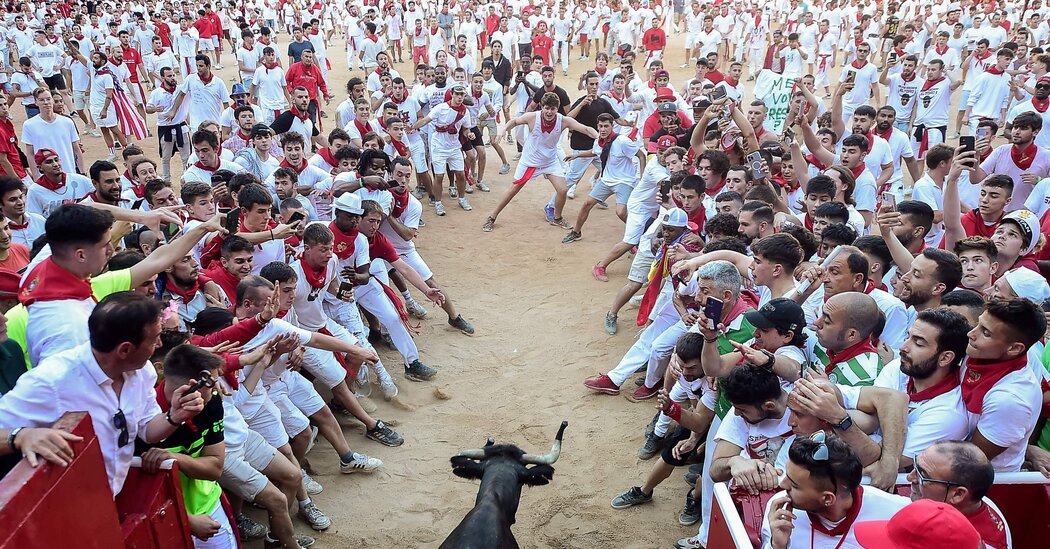
For more than a week in the peak of summer, a sea of people dressed in red and white routinely cram the narrow, cobblestone streets of the northern Spanish city of Pamplona for the ceremonial running of the bulls, a heart-pounding, chaotic race that sometimes ends in severe injury or even death.
Known as “encierro,” the races returned this year after a two-year hiatus because of the coronavirus pandemic. They are the most famous part of the San Fermín Festival, which runs through Thursday.
Each morning, six bulls charge toward thousands of brave runners along a half-mile stretch of street to the city’s bullring, where later in the day the animals are killed by professional bullfighters, or toreros. The average duration of each race is less than four minutes.
The event is as dangerous as it looks. Five people, including one on Tuesday, have been gored during the six races so far this year, according to the local authorities. At least two dozen people have been treated for other injuries.
In 2019, the last time the races were run, eight people were gored during bull runs and 35 others were treated for other injuries, city officials said. Sixteen people have been killed in bull runs in Pamplona since 1910. The last death occurred in 2009, when a man was gored in the neck.
The festival is named after a bishop who was beheaded in the third century, according to city officials. By the Middle Ages, San Fermín was already being celebrated with religious ceremonies and a meal for the poor of the city. Over the years, music, comedies and other elements were added to the festival, and, in the 16th century, the celebration was moved to July from October, which coincided with a trade fair and organized bull fights. The festival grew even more popular in the 20th century with the development of transportation and the expansion of tourism.
The number of runners in a weekday bull run can reach 2,000, with nearly double that during the weekend races, but the tradition has been criticized by animal rights groups.
For the past 20 years, PETA and AnimaNaturalis, a Spanish animal rights group, have protested the bull runs. On the day before this year’s festival, dozens of demonstrators marched in the streets, some wearing dinosaur costumes to signify that the running of the bulls and the bullfights were relics from a less enlightened era.
Ingrid Newkirk, the co-founder of PETA, said in a statement that Pamplona’s event was a “cruel, disgusting gore-fest” and called for it to end. “We have suggested that the city raise its revenue from other types of entertainment, such as a tomato stomp or a ball run, and have even offered cash to end the bull torture,” Ms. Newkirk said. Over the past two years, PETA has offered the city nearly 300,000 euros (about $300,000) to end the bull runs and subsequent bullfights.
Alberto Rojo Puebla, 34, a train conductor from Alcalá de Henares, about 200 miles south of Pamplona, traveled to the festival this year to soak up the culture, despite not being a fan of bullfighting.
“For me it was very special, above all, because I was able to experience everything from the ‘inside’ by staying with people from the city,” he said. “You can see the traditions they have — the charanga music, the food served with vermouth — and understand them better.”
Greg Harris, a lawyer from Toronto, was drawn to Pamplona by Ernest Hemingway’s descriptions of the running of the bulls in his 1926 novel “The Sun Also Rises.”
Mr. Harris, 58, said he woke up early on Monday to join other runners. “There was a palpable nervousness in the crowd,” he said. “Everyone was just a little on edge.”
Although he was not injured in the run, he marveled at the animals’ speed. “In no time, the bulls are on you,” he said. “They were just so fast.”
Despite the apprehension he felt before his first run, Mr. Harris said he was eager to run again.
“The way I did the run today, I was happy with it,” he said. “Obviously as a first-time runner I should just be happy being safe at the end of the run. But I think I could do a better job of being even closer to the bulls and still safe.”
Derrick Bryson Taylor reported from London, and Francheska Melendez from Cercedilla, Spain.





